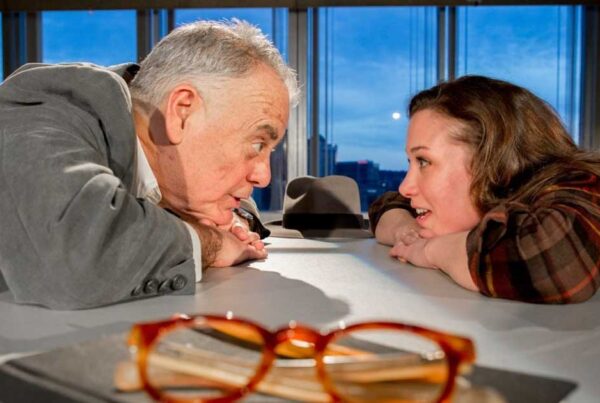
Pittsburgh Post-Gazette – Rest assured, the most famous Shakespearean stage direction is fully honored: “Exit, pursued by a bear.”
Otherwise, Shakespeare is thoroughly, ambitiously remade in “The Winter’s Tale” by director Karla Boos of Quantum Theatre, Andres Cladera and the musicians of Chatham Baroque, the dancers of Attack Theatre and designers of inordinate invention.
I thought my focus in reviewing this world premiere would be on Shakespeare: how would he emerge from transformation into a baroque opera, with its elaboration of music, song, dance and fanciful projections? The answer is that although Shakespeare provides story and dialogue, he serves mainly as the occasion for dizzying creations by others.
The best analogy is to what they did with Shakespeare in the original baroque age, the late 17th century, submerging his poetry and drama in showmanship. But then they did it to gild what they considered an old-fashioned lily; here, the Bard is respected and the result is enchantingly tragicomic, delicious in many ways.
I particularly admire the use of four Attack Theatre dancers, perpetually shaping the story with energy and wit. They drive the narrative while commenting with mimic impudence. And they seem perpetually on stage, given the half-dozen acting areas afforded by the lovely little Union Trust Building auditorium as adapted by Quantum’s resident designer, Tony Ferrieri.
Enchanting is the word for Joseph Seamans’ projections, pelting us with colorful petals and putti, embracing us with images both still and moving. These run from childlike (like the ultimate pop-up book) to horticultural (flowers galore) and from illustrative (a heaving sea and ship in peril, a hall replete with Berninis) to erotic (a cornucopia of luscious Renaissance nudes).
The images are witty, colorful and generous, all the more seductive for not being dulled with overkill. Matching them in invention are Susan Tsu’s lavish costumes, generally based on the late 17th and early 18th centuries, but alluding freely to other eras.
As to Shakespeare, his text is of course pruned, leaving what can best be adapted to aria or recitative. Some scenes are gone or treated only in passing; lines are moved from one character to another; some are supplied to cover what is cut. Perdita’s shepherd stepfather becomes a mother. The aged Camillo is played by a young woman.
But what matter? The dancers, music and projections fill in much of the story, and at nearly three hours, we don’t really want more. In addition, the text is projected as compact surtitles, for which more people will be grateful than will admit.
The acting is sometimes appropriately melodramatic and sometimes just stolid, as can be true of singers who have plenty else to do. Even pungent passions turn more sonorous than sharp. The liveliest are Gail Novak Mosites, an energized Paulina; Raquel Winnica Young, a sympathetic, nuanced Hermione; and Andrey Nemzer, playing the rustic con man Autolycus with ample girth and a beguiling countertenor.
If it ain’t baroque, don’t fix it, goes the adage, but that doesn’t apply to the audacity of this creation, making something new out of much that is old. As a play, this “Winter’s Tale” lacks the nightmare threat of Shakespeare, but as opera-dance theater, it captures his joyous rebirth, afloat on the music of Handel and Co. As self-confident as it is audacious, it is a remarkable creation to mark the 25th year of both Quantum and Chatham Baroque.





Intriguing way to perform Winter’s Tale. I think the Bard himself would have enjoyed the music; I know I did. The auxiliary activities of the dancers and projected images offered more to look at for those unmoved by sound, though some worked better than others — dancers as clocks, or sinuous lizards among burgeoning ivy the best, and projected statue awesome. Lots of standout singers, but my favorite the counter tenor Rogue. A clever, fun production.